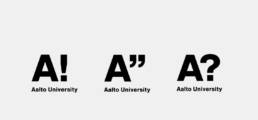Universities are not often known for having fresh and innovative brand identities. Frequently hampered by history and royal insignia they are often predictable and lacking in imagination. In fact, the World 100’s 2017/2018 ‘Brand Snapshot’ research found that 50 universities use the same or similar shade of blue in their visual identity.
But one university has thrown out the rule book and brought a completely new concept and way of visual branding to the world of higher education. World 100 Director, Louise Simpson, explored the origins and creative thinking behind the visual identity of Finland’s Aalto University during the THE Young University Summit, when she spoke to their president, Ilkka Niemelä.
Aalto University is one of the world’s leading young universities. Founded in just 2010 from a merger of three existing universities in Helsinki, Aalto specialises in science technology, business and art and design. It would have been easy for Aalto to adopt the same format as more well-established university brands. However, instead of focusing on location, and history, Aalto chose to highlight its principles and disciplines.
So what does Aalto’s logo look like and what does it mean? “Is this saying ‘do we exist?’ Is it existential? Is it a joke? Is it drawing attention to the knowledge of questioning? Or everything?”, Louise asked.

Ilkka explained: “It is actually even more complicated than that because the letter ‘A’ can take different colours and instead of having just the single logo we actually have three families of logos; one with a question mark; one with an exclamation mark; and one with a quotation mark. And the idea of not having a single static logo was to really deliver the message that Aalto is very dynamic, multi-faceted, multi-disciplinary, challenging, and engaged in the society – so we ask questions, we really carry the knowledge but also assert things – a kind of influencer in the society.
“So it has very many aspects and it’s really interesting. I think it was one the things people noticed as the first thing; they noticed that this is something different because the logo is not something you expect from the university.”
But what does Aalto refer to? There is nowhere in Helsinki, Finland or even Europe called Aalto. The university chose to completely strip location from its identity, instead taking inspiration from an alumni of one of their founding institutions. Alvar Aalto is famous for his architecture and fabulous chair design. So what was it specifically about Alvar Aalto that led to naming the university after him and is there anything else in the brand that was inspired by the designer?
“Definitely! A lot of things.” Ilkka commented. “First of all, Aalto is our alumnus; he graduated from one of our founding universities as an architect. Aalto has actually shaped our campus in a major way; so he actually did with his wife the general plan of the campus and designed some of the landmark buildings there. He was very international, worked very broadly, for example in the US, which was interesting in that time and very multi-disciplinary.
“He was not just an architect, but also a furniture designer and an industrial designer. He’s open-minded and uses this kind of creative research-oriented approach. Really when you look at his work it tackled problems in depth and avoided settling for anything ordinary.

Source: Public domain.
Taken from Wikipedia
“He was very radical in using old themes in new ways and this is something that we aspire to at Aalto as well; we try and attempt to break the traditional barriers between different disciplines and also this kind of experimental and open-minded work that you see in the Otaniemi campus, with very modern buildings that have this characteristically Finnish tone but are very international and global”.
So what was it that led to such an innovative, brave concept that defies higher education branding norms? Ilkka states that changes in the way Finland’s government dealt with universities, providing them with a higher degree of autonomy, was a key factor in shaping Aalto itself. “Because of the reform it was possible to found Aalto as a private foundation-based university and this offered interesting possibilities. And in applying this strategy to the creation of an institution, it was only right that such freedom carried over into the design of its identity”.
“I think it was brave decision,” says Ilkka. ‘All our founding universities have each have a history that stretches to the 19th Century and their local brands. But was decided that we wanted to create something really different and new … not based on any of the brands but really on the collaboration and joint efforts that actually have a global outreach. That was a brave decision and criticised when we started but I think it was something that gave room for creating something completely new.”
Read more about how Aalto has managed to make such an impression since their creation in 2010 in our follow-up piece.

